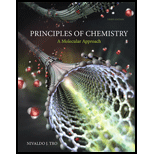
Hard water often contains dissloved
Want to see the full answer?
Check out a sample textbook solution
Chapter 4 Solutions
Principles of Chemistry: A Molecular Approach Plus Mastering Chemistry with eText -- Access Card Package (3rd Edition) (New Chemistry Titles from Niva Tro)
- Can you please explain this problems to me? I'm very confused about it. Please provide a detailed, step-by-step explanation for me! (ME EX1) Prblm 30arrow_forwardThis organic molecule is dissolved in a basic aqueous solution: O ? olo RET A short time later sensitive infrared spectroscopy reveals the presence of a new C-OH stretch absorption. That is, there Ar must now be a new molecule present with at least one C - OH bond. In the drawing area below, show the detailed mechanism that could convert the molecule above into the new molecule. $ Add/Remove steparrow_forwardSo the thing is im trying to memorize VESPR Shapes in order to be able to solve problems like so, and I need help with making circles like the second image that's in blue or using an x and y axis plane in order to memorize these and be able to solve those type of problems. Especially like the ones given in the top / first image. (180 , 120 , 109.5) Can you help me with this.arrow_forward
- Don't used hand raiting and don't used Ai solutionarrow_forward2. (15 points) Draw an appropriate mechanism for the following reaction. H N. H* + H₂Oarrow_forwardDraw a tripeptide of your choosing at pH 7. Have the N-terminus on the left and the C-terminus on the right. Then: Draw a triangle around the α-carbons. Draw a box around the R-groups. Circle the atoms capable of hydrogen bonding. Highlight the atoms involved in the formation of the peptide bonds. What type of structure have you drawn? (primary, secondary, tertiary or quaternary protein structure). make sure its a tripeptidearrow_forward
- > Organic Functional Groups Naming and drawing alkyl halides structure CI Br CI CI Explanation Check 2 name 1-chloro-2,4,9-trimethylnonane CI 2-iodo-2,3-dimethylbutane FEB 19 € E M tv MacBook Airarrow_forwardCan you please explain to me this problem im very confused and lost. Help me step by step and in detail im soo lost.arrow_forward2) There are many forms of cancer, all of which involve abnormal cell growth. The growth and production of cells, called cell proliferation, is known to involve an enzyme called protein farnesyltransferase (PFTase). It is thought that inhibitors pf PFTase may be useful as anticancer drugs. The following molecule showed moderate activity as a potential PFTase inhibitor. Draw all stereoisomers of this compound. HO OHarrow_forward
 Principles of Modern ChemistryChemistryISBN:9781305079113Author:David W. Oxtoby, H. Pat Gillis, Laurie J. ButlerPublisher:Cengage Learning
Principles of Modern ChemistryChemistryISBN:9781305079113Author:David W. Oxtoby, H. Pat Gillis, Laurie J. ButlerPublisher:Cengage Learning Chemistry: Principles and PracticeChemistryISBN:9780534420123Author:Daniel L. Reger, Scott R. Goode, David W. Ball, Edward MercerPublisher:Cengage Learning
Chemistry: Principles and PracticeChemistryISBN:9780534420123Author:Daniel L. Reger, Scott R. Goode, David W. Ball, Edward MercerPublisher:Cengage Learning Chemistry: The Molecular ScienceChemistryISBN:9781285199047Author:John W. Moore, Conrad L. StanitskiPublisher:Cengage Learning
Chemistry: The Molecular ScienceChemistryISBN:9781285199047Author:John W. Moore, Conrad L. StanitskiPublisher:Cengage Learning General Chemistry - Standalone book (MindTap Cour...ChemistryISBN:9781305580343Author:Steven D. Gammon, Ebbing, Darrell Ebbing, Steven D., Darrell; Gammon, Darrell Ebbing; Steven D. Gammon, Darrell D.; Gammon, Ebbing; Steven D. Gammon; DarrellPublisher:Cengage Learning
General Chemistry - Standalone book (MindTap Cour...ChemistryISBN:9781305580343Author:Steven D. Gammon, Ebbing, Darrell Ebbing, Steven D., Darrell; Gammon, Darrell Ebbing; Steven D. Gammon, Darrell D.; Gammon, Ebbing; Steven D. Gammon; DarrellPublisher:Cengage Learning ChemistryChemistryISBN:9781305957404Author:Steven S. Zumdahl, Susan A. Zumdahl, Donald J. DeCostePublisher:Cengage Learning
ChemistryChemistryISBN:9781305957404Author:Steven S. Zumdahl, Susan A. Zumdahl, Donald J. DeCostePublisher:Cengage Learning Chemistry: An Atoms First ApproachChemistryISBN:9781305079243Author:Steven S. Zumdahl, Susan A. ZumdahlPublisher:Cengage Learning
Chemistry: An Atoms First ApproachChemistryISBN:9781305079243Author:Steven S. Zumdahl, Susan A. ZumdahlPublisher:Cengage Learning





